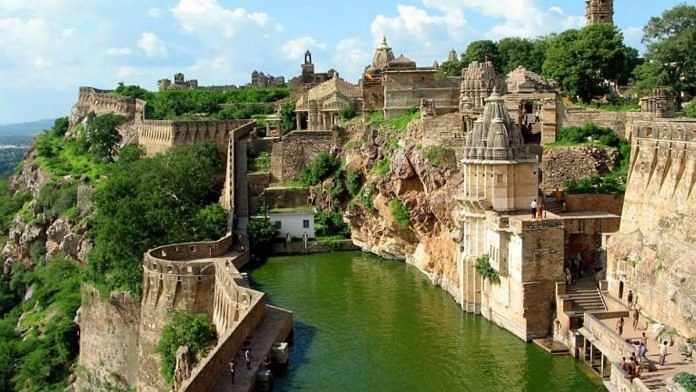New Delhi: The Supreme Court has put a hold on the use of explosives for mining of minerals in a five-kilometre radius of the Chittorgarh Fort, a UNESCO world heritage site in Rajasthan.
A two-judge bench of Justices Sanjiv Khanna and S.V.N. Bhatti, however, allowed the continuation of manual mining within the same radius, subject to the lessees possessing a valid licence in accordance with the law.
“We declare and hold that notwithstanding any liberal recommendation on undertaking blasting operations nearer to the Chittorgarh Fort, keeping in perspective the continuous exposure of ancient monuments to peak particle velocity arising from blasting, a radius of 5 km from the compound wall of the fort shall not be subjected to mining by blasting or use of explosives for mining of any minerals,” the bench said in a judgement pronounced Friday.
A direction was also issued to the Chairman of the Indian Institute of Technology (Indian School of Mines) in Dhanbad, Jharkhand, to constitute a team of multi-disciplinary experts in civil engineering, earthquake engineering, structural geology and mining engineering to study possible environmental pollution and impact on all structures in the Chittorgarh Fort from blasting operations beyond the five-kilometre radius. This has to be done within two weeks of receipt of the judgment copy, the court said.
The court further fixed a four-month deadline for the IIT committee to complete its study and directed the Rajasthan government to prepare a list of leaseholders carrying out mining operations beyond a five-km and within a 10-km radius of the fort. The details have to be furnished to the committee.
The court also directed the state to stop mining operations carried out through blasting without waiting for its orders, if the committee at any place observed unexpected damage to the structures in the fort.
“The exploitation of minerals available in the surrounding area by lessees to the state government, particularly in an unscientific manner or disproportionate exploitation of minerals in hard and rude mining activities, was seen as a threat to the existential utility of the Chittorgarh Fort and the structures,” the order noted.
A separate direction was issued to the director general of the Archaeological Survey of India (ASI) to file a report on the monument’s deficiencies and the steps initiated to maintain it. The report must also contain the progress the ASI makes in its work till 9 July, which the court fixed as the next date of hearing.
The top court’s judgment came on an 11-year-old appeal filed by a mining company against a Rajasthan High Court order that had issued interim directions on a PIL to stop blasting operations within a 10 km radius of the fort. The petitioner before the SC has a mining lease of more than 590 hectares at a distance of about 4.5 km from the boundary of the Chittorgarh Fort.
Pursuant to issuing notice on the appeal, the apex court permitted a study of cumulative impacts of vibrations and peak particle velocity on the structures in the fort from the blasting operations. Central Building Research Institute, Roorkee, was asked to undertake a comprehensive study of the environmental impact as well.
Also Read: 31% of judges’ posts vacant in high courts, 21% in district judiciary, finds SC report
‘Fort has withstood many battles’
A protected monument, notified under the Ancient and Historical Monuments and Archaeological Sites and Remains (Declaration of National Importance) Act, 1951, the fort is a world heritage site that attracts a large number of foreign tourists for sightseeing. Noting this aspect, the court said, the fort stands among the strong structures in Rajasthan, evidencing grit and ability to withstand all adversities.
The geology of the area has limestone formation of the Vindhyan basin, making the area a valuable source for mining operations.
Talking about the fort’s historical importance, the top court’s order gave reasons for the monument’s preservation. Despite the passage of centuries, from the time of its construction, the Chittorgarh Fort retains some significant, world-class structures, including the Vijay Stambh, Kirti Stambh, Padmini Palace, Kumbha Palace and Meera Mandir.
“The Chittorgarh Fort represents the quintessence of a tribute to nationalism, courage, mediaeval chivalry, and sacrifice exhibited between the seventh and the sixteenth centuries by several rulers, like the Mewar rulers of Sisodia, their kinsmen, women and children,” the order remarked.
“The fort has weathered and withstood many battles and has been a witness to the power and pride of the kinds who occupied the fort,” it added.
The order quoted from history, saying it is replete with “brave, extraordinary and indomitable courage exhibited by the rulers and occupants of the fort”.
(Edited by Nida Fatima Siddiqui)
Also Read: Courts still use ‘jamadar’ as post, need to shed colonial mindset, says SC report



